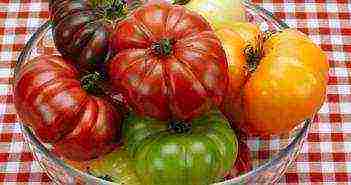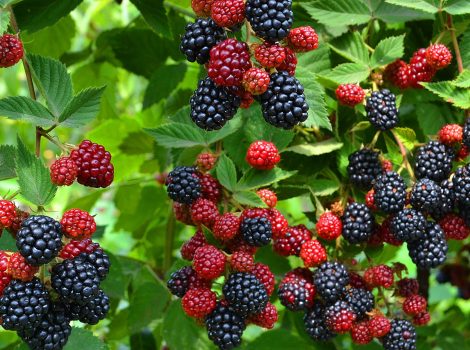Content
- 0.1 Chili peppers - what do we know about them?
- 0.2 The most popular varieties of chili peppers - description, photo
- 0.3 Watch the video "How to grow chili peppers at home: natural spices on your windowsill!"
- 1 The best varieties of indoor peppers
- 2 The best spicy peppers outdoors
- 3 The best varieties of early ripe peppers
- 4 The best mid and late ripening varieties
- 5 Popular varieties for giving
- 6 Why do we need pepper
- 7 How to choose a variety
- 8 Hot pepper varieties
- 9 How to grow peppers in a greenhouse or at home
- 10 Harvesting hot peppers
If your life lacks thrills, try bringing them in with hot peppers. It will not only spice up your favorite meal, but it will also make your brain work better, strengthen your hair and bring you out of stress. You can grow hot peppers both in the garden and on the balcony or window.
On this page of the site for beginner farmers, we decided to consider the most popular chili peppers... Photo and description, we hope, will help you choose what you need. Isn't it time to add pepper to your life?
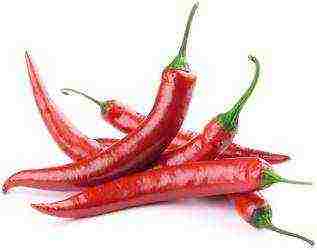
Chili peppers - what do we know about them?
His homeland is considered to be tropical America of those times when it was inhabited by the indigenous population - the Indians. Today it is mainly grown in India and Thailand. Chili is a name for several varieties of hot peppers. Although it translates as "red", in fact, the fruit can have yellow or even dark shades.
The pungency of chili is given by the unique substance contained in it - capsaicin. Its amount is measured in scovills and is designated as SHU. Bell peppers are endowed with zero scovillas, the mildest chili pepper contains from 100 to 500 scovillas, and the hottest (it was included in the Guinness Book) contains more than 1 million scovillas. Fresh milk fights pepper fire most effectively in the mouth.
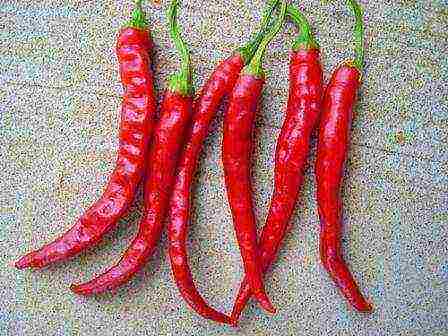
The most popular varieties of chili peppers - description, photo
Burning bouquet
A plant up to half a meter in height with 10-centimeter fruits, which, as gourmets describe, have a special peppery aroma. The hot bouquet belongs to the early varieties, it can be grown outdoors and in shelter.
In the photo, a variety of chili peppers Burning bouquet
Double abundance
Long (18-20 cm) thick-walled proboscis pepper. The variety in question has three main advantages: high yield, resistance to viruses and strong summer heat.
Thick-walled Hot Pepper Double Abundance
Chinese fire
Pepper pods are long - up to 25 cm and have a particularly strong pungency. The plant stretches up to 65 cm and exhibits good disease resistance.
Long pepper pods chinese fire
Indian elephant
Trunk-shaped thick-walled peninsular peppers, each weighing about 30 g. Plant height can reach 1.3 m. The variety is very fruitful and very aromatic.
Unripe Peninsular Pepper Indian Elephant
Jalapeno
The height of the bush is usually approximately 1 m, the length of the peppers is 10 cm. On average, 35 peppers ripen on each plant. To get the full harvest, it is better to grow this pepper in greenhouses. They pluck Jalapenos without waiting for maturity.
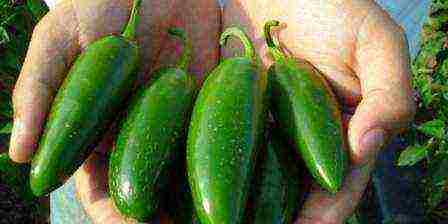 In the photo, Jalapeno chili pepper
In the photo, Jalapeno chili pepper
Habanero Tobago Seasoning
Pepper has a somewhat "crumpled" appearance and can be not only red, but also have other colors (yellow, brown, pink). Average weight - 15 g, has a fruity flavor. On one bush there are up to 1000 bright peppers.
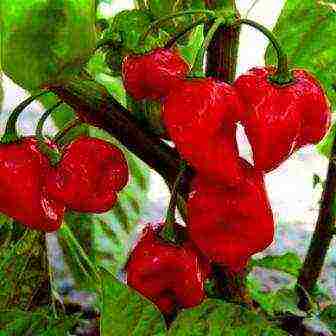 Habanero Tobago Seasoning
Habanero Tobago Seasoning
Cayenne red
Fruits are thin, each about 12 cm long, pungency is average. A one and a half meter bush requires a garter. A very productive variety of pepper - about 40 peppers can be picked from one bush.
Cayenne red pepper
7 Pot Brain Strain Red
A late variety of pepper, which stands out for its unusual fruit shape (see photo) and a very bright fruity aroma.
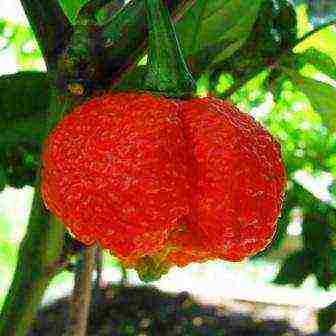 7 Pot Brain Strain Red
7 Pot Brain Strain Red
Vizier
The fruits are very unusual in appearance (see photo), with a wall thickness of 3 mm, medium sharp. The bush is quite tall and spreading. Vizier is a very productive late variety.
In the photo, an unusual type of chili Vizier
Tabasco
A high-yielding chili pepper variety, late ripening. One and a half meters is the usual height for this plant, 5 cm is its usual length. Pungency is medium. This variety is resistant to many diseases.
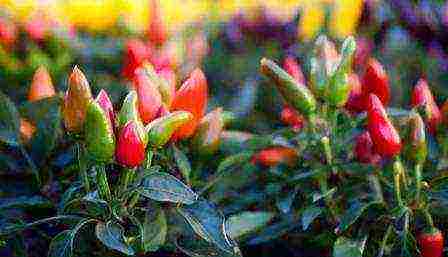 Tabasco
Tabasco
Jati jolokia
The pepper of this variety is truly spicy. The bush does not grow more than 40 cm, the fruits are beautiful, drooping. Late grade.
In the photo, a late variety of chili peppers Jati Jolokia
We have brought to your attention the best varieties of chili peppers. Photos and descriptions should help you make your choice. Add hot, healthy chili to your lean life!
Watch the video "How to grow chili peppers at home: natural spices on your windowsill!"
The name "chili" is used in trade and in cooking to refer to the cayenne pepper Capsicum annuum, and is also applied to all of the hottest red hot peppers to distinguish them from medium- to low-burning. The name “chile” in Russian is consonant with the name of the country of Chile, but in fact it comes from the word “chilli” from the Nahuatl Astek languages (the territory of modern Mexico) and translates as “red”.
The pungency of a pepper is measured on the "Scoville Hotness Scale". This scale was proposed by the American chemist Wilbur Scoville for a comparative assessment of the degree of hotness of different varieties of pepper. The Scoville Scale Units (ECU) provide an estimate of the quantitative content of capsaicin and are based on sensory testing of pepper extracts. It is capsaicin that gives the pepper a hot taste, it is associated with the perception of substances that stimulate "heat" receptors. Capsaicin is widely used in medicine, but not only. For example, it is a component of an alcoholic tincture and a medical patch used as a distraction and pain reliever, as well as an ointment for frostbite. Capsaicinoids are used in self-defense gas weapons: gas pistols and revolvers, gas canisters.
To make it clearer, sweet bell peppers correspond to 0 on this scale, tabasco sauce - 5,000 units, jalapenos - 8,000 units, hot Thai peppers - 50-100 thousand. By the way, being in Thailand, I tried the dishes that Thais prepare for themselves and, to be honest, I couldn't eat more than two spoons. Jamaican hot pepper gains 100-200 thousand units. The peppers, which I will talk about in today's post, start at 225 thousand (!) On the Scoville pungency scale.
So let's get started. I must say right away that the most interesting and extreme is at the end of the list.
22nd place. Madame Jeanette (225,000 units)
This type of pepper is native to Suriname. According to one version, it got its name from a prostitute from Paramaribo. The harmless-looking smooth yellow pod contains a powerful charge of spiciness. It has no fruity or floral notes, it's just spicy. Madame Jeanette can be found in traditional Surinamese and Antillean cuisine. This variety is often confused with "yellow Suriname" - a yellow Surinamese chili, but mature Madame Jeanette peppers are reddish-yellow in color, they are larger and irregular in shape. The plant is very productive, grows little and does not like coolness, it can grow indoors.
21. Scotch Bonnet (100,000 - 350,000 units)
Scotch bonnet is found mainly in the Caribbean, Guyana (where it is called "fireball"), the Maldives and West Africa. It got its name in honor of the resemblance to the traditional Scottish headdress of the tam-o-shanter. This is a wide woolen beret with a pom-pom at the top of the head. These peppers are used to flavor various dishes, as well as in hot sauces and condiments. It gives pork or chicken dishes a unique flavor.Scotch bonnet has a sweeter taste and thicker shape than its habanero cousin, with which it is often confused.
20. White habanero (100,000 - 350,000 units)
This habanero variety is rare because it is difficult to grow. The fruits of the white habanero grow on tiny bushes, but are extremely productive. There are different opinions about the origin of the variety (Peru or Mexico), but it is most often found in Mexican cuisine.
I suggest you watch a video review of the white habanero with a tasting. As it turned out, this is a fairly popular genre of video reviews on YouTube. The internet is filled with videos of blushing and sweating men munching on different varieties of peppers.
19.Klassic habanero (100,000 - 350,000 units)
Despite its official name Capsicum chinense, the classic habanero comes from South America. Nikolaus Jacquin, who discovered this plant, mistakenly believed that it spread from China. This species naturally grows in Brazil, Colombia, Mexico and the Caribbean. The inhabitants of Mexico are immensely fond of spicy food, and dishes with habanero peppers are offered to tourists in the restaurant. The visitor who ordered this hot pepper is immediately respected by the locals. Habanero pepper is part of the famous Tabasco sauce.
18. Fatali (125,000 - 325,000 units)
The Fatali pepper, or South African habanero, is the first pepper on our list that is not native to the Western Hemisphere. South Africa is considered his homeland. This variety has a pleasant fruity flavor. Depending on the place of growth, you can catch the aroma of citrus or peach, although I personally do not understand how you can distinguish any shades of taste when tasting such a spicy product.
17. Devil's tongue (125,000 - 325,000 units)
This variety looks similar to fatali and is also part of the habanero family. This pepper was first discovered on a farm in Pennsylvania, but the history of its origin is unknown. The fruits of this pepper have a bright, fruity, slightly nutty taste (let's believe the experts a word).
16. Tigerpaw NR (265,000 - 328,000 units)
This habanero variety was bred by the USDA Science Laboratory. The prefix NR in the name of the pepper stands for "nematode resistance", which means the resistance of this variety to root nematodes (pests that usually attack pepper bushes). Due to the artificial origin of Tigerpraw NR, the tradition of using it in food has not developed. However, its similarity to the classic orange habanero makes it a substitute for the latter in any dish, although Tigerpraw NT is slightly spicier.
15. Chocolate habanero (aka Congo Black) (300,000 - 425,000 units)
This variety is native to Trinidad and, in fact, has absolutely nothing to do with Congo. Chocolate habanero is particularly popular with spicy drinkers, who can remain conscious long enough to experience the rich "smoky" aroma buried deep under the scalding pungency. This variety can be found in traditional hot sauces from Mexico to Jamaica.
Review-tasting of chocolate habanero:
14. Red Savina (200,000 - 450,000 units)
Another habanero variety, specially bred by breeders in order to get larger and juicy fruits. Like some of the other habanero varieties, Red Savina comes from Central America, but it got its new look in California greenhouses. So that you understand what awaits you on this list further, I will explain: this variety held the palm among the hottest varieties of pepper for 12 years (from 1994 to 2006), and we have not even made it to the middle!
13. Red Caribbean habanero (300,000 - 475,000 units)
This variety is almost twice as sharp as the classic habanero. Like some of the other varieties on this list, the red habanero is native to the Amazon basin, although some believe it has Mexican roots. Red Caribbean habanero is widely used in Mexican cuisine, mainly in salsa and other hot sauces.
12. Trinidad Scorpion CARDI (800,000 - 1,000,000 units)
The Scorpion group of Trinidad got its name from the characteristic tail shape, reminiscent of the tail of a scorpion. Place of origin - Trinidad island. The abbreviation CARDI explains that this variety was bred within the walls of the Caribbean Agricultural Research Institute.To grow and process this pepper, you must wear gas masks and protective clothing similar to chemical protective suits. In its homeland, the Scorpion of Trinidad is used in the military industry to produce tear gas. Also, the capsaicin obtained from it is added to the paint, which is used to cover the bottoms of ships to protect against shellfish.
11.Naga Morich (aka Dorset Naga) (1,000,000 units)
At this point, we move into a completely different category of varieties with a pungency level of over a million Scoville! It is hard to imagine, but "gastromasochists" from all over the world chew these peppers too. Central American habanero varieties will have to make room: the naga pepper family is native to northern India and Bangladesh. There they are usually eaten unripe. In addition to the searing pungency, naga morich boasts a fruity aroma, some fans catch notes of orange and pineapple. One of the varieties of this pepper, Dorset Naga, has been specially eaten for maximum pungency. It was the first variety in the world to cross the 1 million mark on the Scoville scale.
10. Bhut Jolokia (aka Ghost Pepper) (800,000 - 1,001,304 units)
In 2011, Bhut Jolokia (or Naga Jolokia) entered the Guinness Book of Records as the hottest pepper in the world. Now there are already more pungent varieties of chili bred in laboratories, but it is worth remembering that Bhut Jolokia is a natural creation of nature, growing for centuries in India. It is noteworthy that the pungency of this pepper directly depends on the geographical location and climate of the area where it grows. For example, the sharpest Bhut Jolokiya grows in the relatively sparsely populated northeastern part of India, also known as the "Seven Sister States", where it is coated with fences to keep wild elephants away from human dwellings. In the drier state of Madhya Pradesh (the center of the country), it is half as severe as in the northeast. After conducting tests, the Indian Ministry of Defense announced that grenades stuffed with Bhut Jolokia effectively cool the ardor of hooligans. Then the pepper grenades were put at the disposal of the Indian army.
Video:
9.Bhut Jolokia chocolate (800,000 - 1,001,304 units)
The chocolate version of Bhut Jolokia is very rare in the wild. It got its name not only for its characteristic color, but also for its sweetish taste. But don't be fooled: it's just as pungent as its red cousin, with roughly the same capsaicin level of 1 million units. Native to India, these peppers are used in all varieties of curries.
8.7 Pot Chili (over 1,000,000 units)
This chili also comes from Trinidad, where the fiercest peppers grow naturally like weeds. This pepper is found in dishes throughout the Caribbean. In Jamaica, it is called the "seven pots" pepper to show that one pod is enough to fill seven pots of food with flavor and aroma. Like other pungent varieties, 7 pot chili fruits have an uneven, bumpy surface, as if boiling from the inside due to their pungency.
7. Gibralta (Spanish Naga) (1,086,844 units)
As the name suggests, this naga variety is grown in Spain, although it was bred in UK laboratories. To obtain this pungency, Gibraltha is cultivated in extreme conditions: indoors, in closed polyethylene tunnels, using extremely high temperatures. Since it is an artificially bred variety, it is difficult to find it in traditional Spanish cuisine.
6. Infinity chili (1 176 182 units)
Most of the top ten chili varieties have been produced artificially, and Infinity chili is no exception. It was bred by British breeder Nick Woods, but held out in the title of hottest pepper for only two weeks. Like the previous two varieties, it is as red, bumpy and bad looking, just like those hobby tasters after they taste it.
five.Naga Viper (1,382,118 units)
Nature could not invent a pepper as hot as the Naga Viper. This is so unnatural that this variety loses its properties with each new bush. Naga Viper is an unstable genetic hybrid of three other chili varieties: Naga Morich, Bhut Jolockia and Trinidad Scorpion. If you would like to buy seeds and try to grow the Naga Viper yourself, sign up in line with Gerald Fowler, the UK breeder who bred the strain. At the moment, there are already several thousand people on the list.
4.7 Pot Douglah (aka Chocolate 7 Pot) (923,000 - 1,853,396 units)
A chocolate variety of 7 pot chili from Trinidad is approaching the dangerous 2 million Scoville mark. Fans say this is one of the juiciest and most flavorful chili varieties. The word "dougla" in Trinidad refers to people of mixed African and Indian blood.
3. Trinidad Scorpion Butch T (1,463,700 units)
The Trinidad Scorpion Butch T was listed in the Guinness Book of Records in 2011. It was obtained by crossing other varieties and named after Butch Taylor of the United States, who raised them from the seeds of another pepper lover. To prepare food using this pepper, you need protective equipment: mask, gloves, protective suit. The chefs say that the numbness in the hands lasts about two more days after cooking.
2. Trinidad moruga scorpion (2,009,231 units)
This variety crossed the 2 million mark on the Scoville scale for the first time and held the title of the hottest pepper in the world for several years. It is the hottest pepper found in the wild and is native to the Moruga region of Trinidad (of course). A medium-sized fruit contains about 25 ml of pure capsaicin: about the same as a police pepper spray. If you decide to take a bite of Trinidad Moruga Scorpion pepper, then in the first minutes you will think that it is not spicy at all. However, after a few minutes, the degree of pungency will begin to grow rapidly, and it will seem to you that your tongue, throat and esophagus are on fire! The blood pressure will rise, the face will turn red, and the eyes will begin to water heavily. Some people who tried this pepper had bouts of nausea. In addition to the pungency, Trinidad Scorpion Moruga Blend is notable for its fruity aroma, thanks to which its fruits, added in very small quantities, give the dish a spicy and, at the same time, pleasant taste.
1. Carolina Reaper (1,569,300 - 2,200,000 units)
The leader of the rating is Carolina Reaper pepper, grown in South Carolina on the farm of Ed Curry, owner of PuckerButt Pepper Co. Carolina Reaper, declared the hottest pepper in November 2013, outpaced its closest competitor by 200,000 units. Like its other closest relatives from Trinidad, it is equipped with a bumpy surface and a scorpion's tail.
In this funny video, two reckless fellows taste the Carolina Reaper:
source
Let me remind you of something else interesting about food and food: Watermelon carving from Clive Cooper, and here, for example, Centennial eggs. These are the paws of a bear and they are eaten. I can even tell you How to eat the NEST! and Is it okay to eat stones? Well, also see how the Delicacy looks like in Vietnamese
This article covers the best hot pepper varieties. They are of early, middle, late ripening. They grow in various conditions. Certain types of indoor hot peppers.
The best varieties of indoor peppers
Indian summer
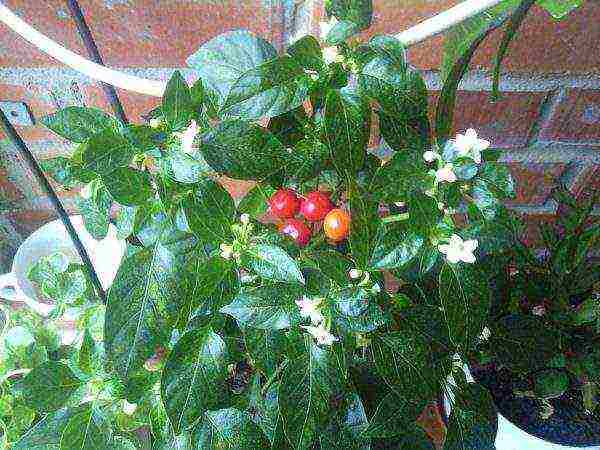 Indoor pepper Indian summer
Indoor pepper Indian summer
Shade-tolerant, undemanding plant. It can grow on a loggia for several years, or on the ground as an annual plant. The bush is low, 30-40 cm, it is strewn with small globular peppers, differing in color variety. Red is used without additional processing. The wall thickness is 3 mm, the taste is sweetish with sourness, spicy.
Hungarian yellow
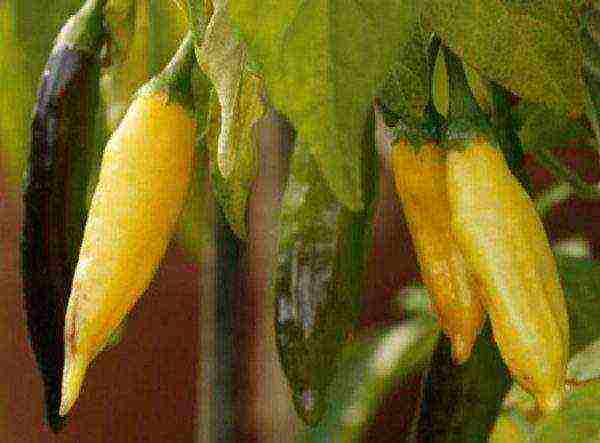 Hot peppers Hungarian yellow
Hot peppers Hungarian yellow
Early ripe, adapted to cold weather, small bush, about 25 cm... The vegetable looks like a cone hanging down. In the process of formation, yellow, when ripe, turns red. The wall thickness in the section is 4 millimeters. Juicy, sweetish, semi-sharp.
Goldfinger
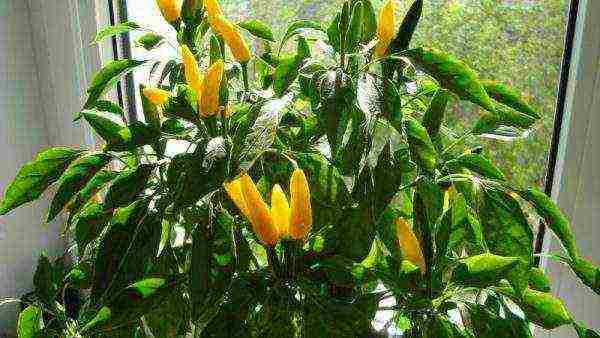 Hot pepper Goldfinger
Hot pepper Goldfinger
Photophilous, early ripening plant, profusely flowering, 25 cm high. Pods up to 5 cm long, yellow... It grows well and gives a lot of production on lighted windowsills.
The plant is grown as an ornamental plant with inedible fruits.
Filius Blue
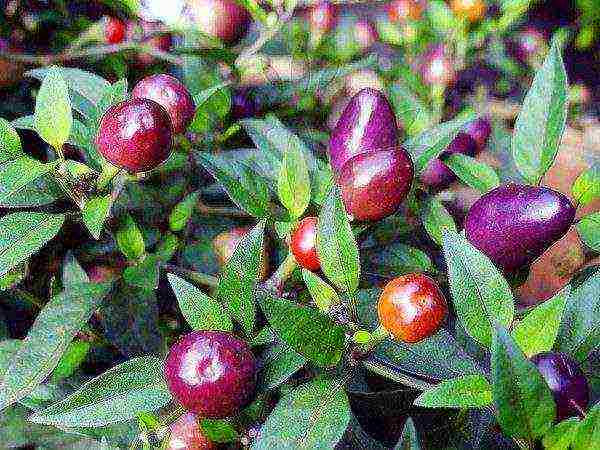 Hot pepper Filius Blue
Hot pepper Filius Blue
A beautiful perennial plant with fruits that can be eaten. The height of the bush reaches 20 centimeters, unripe peppers are purple, the red color indicates its ripeness. For the plant, it is necessary to provide a sufficient amount of light, moderate watering, moist air. If grown in an apartment and properly cared for, it will bear fruit for a whole year.
The best spicy peppers outdoors
Adjika
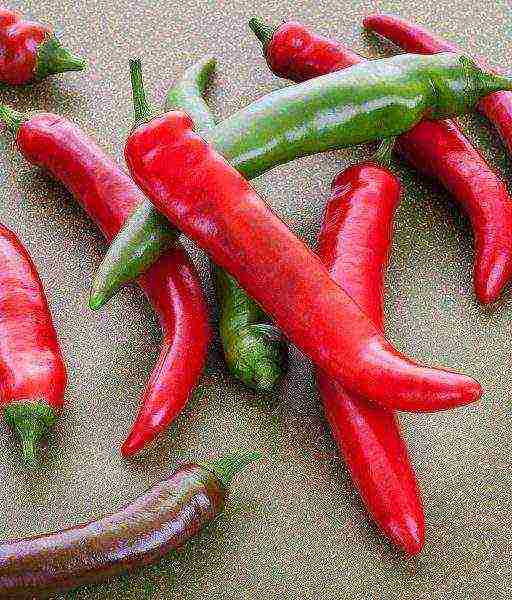 Hot pepper grade Adjika
Hot pepper grade Adjika
Medium early, tall. Grows up to a meter in height. The bush is strong, lush. The fruits are large, conical, bright, red, spicy with a pleasant aroma.
For mother-in-law
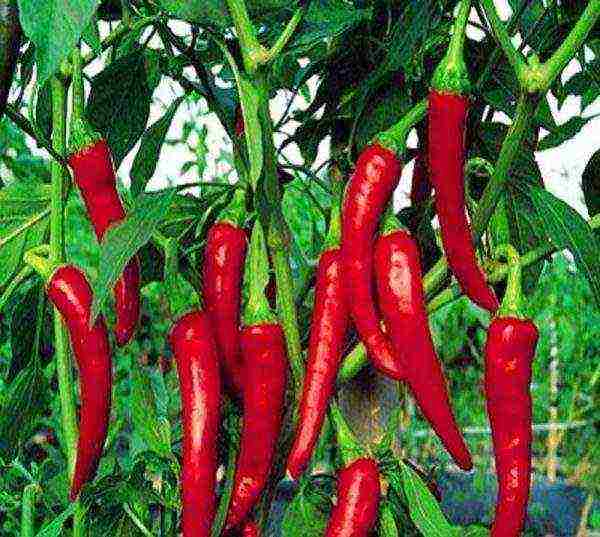 Hot pepper grade For mother-in-law
Hot pepper grade For mother-in-law
Early, with a high yield. Below average height, cone-shaped fruits, red, strong smell, pungent taste.
The Queen of Spades
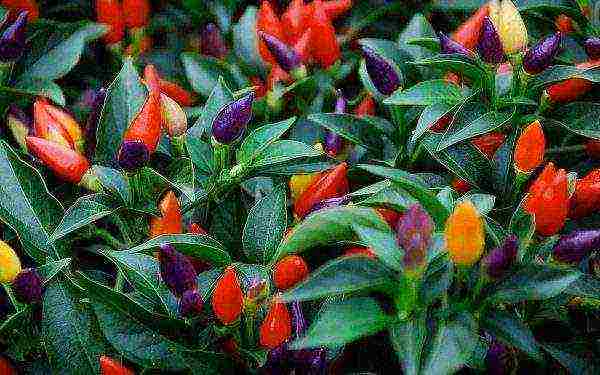 Hot pepper grade The Queen of Spades
Hot pepper grade The Queen of Spades
Mid-season. Bushes are small, spherical. There are a lot of fruits, of varying degrees of maturity and color. It looks very nice. Grows well in shady areas. The fruits are cone-like, growing upward. The taste is spicy with sweetness.
Dragon tongue
 Hot Pepper Dragon's Tongue
Hot Pepper Dragon's Tongue
Mid-season. The bushy plant grows up to a meter in height, unpretentious to care for. Ripe fruits are long, rich red color, burning, with a pleasant aroma.
Goes to the production of paprika.
Bully
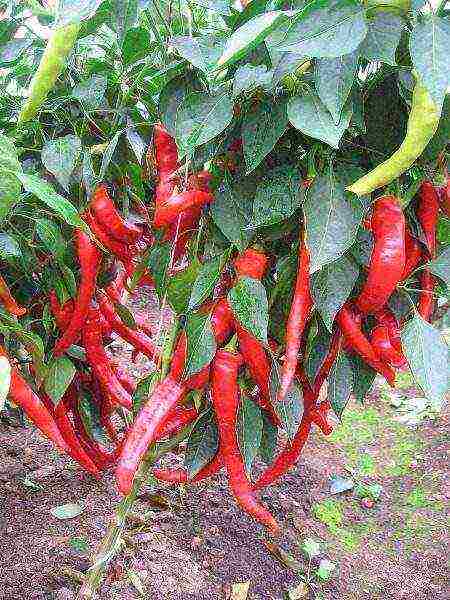 Hot pepper Bully
Hot pepper Bully
Mid-season. The bush is small, semi-spreading, grows up to 70 cm... The fruits are long, proboscis-shaped, red. In a section with a thickness of 1.5-2 mm. High resistance to cold weather, high yield. Low aroma, semi-pungent taste.
Doesn't like shadow.
The best varieties of early ripe peppers
Impala
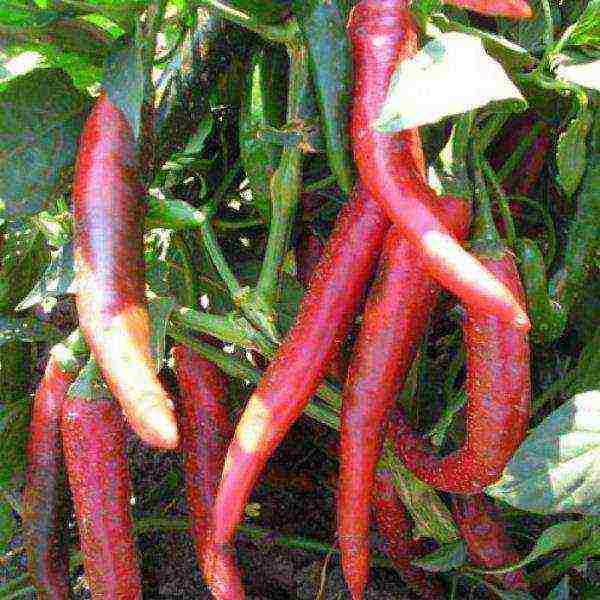 Hot Impala Pepper
Hot Impala Pepper
It tolerates heat well, ripens early, brings a large harvest. The bush is massive, reaches a height of 70 cm, dotted with peppers... They are large, weighing 80 grams. When ripe, it becomes deep red. The vegetable has an interesting taste and pungency. Reference! Resistant to tobacco mosaic virus.
Wit
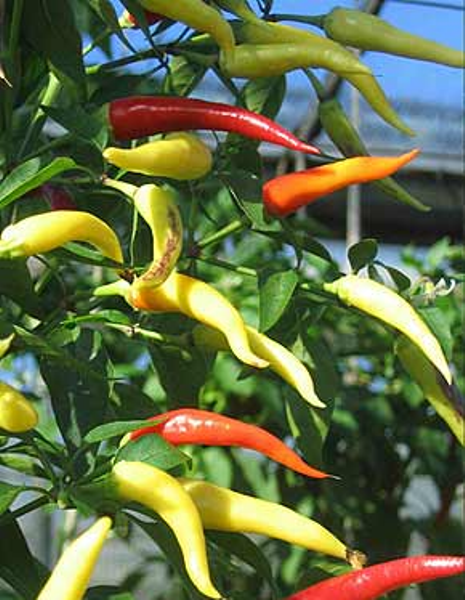 Hot pepper grade Wit
Hot pepper grade Wit
Early ripe. Grows in open and closed ground. The bush is small, medium height, large-leaved. Fruits are red, with a dark shade, shiny, conical, growing upwards. The yield is high. It is not affected by diseases and temperature changes.
The variety tolerates drought well, but cannot tolerate poor lighting. Suitable for drying, storage, salting.
Tula
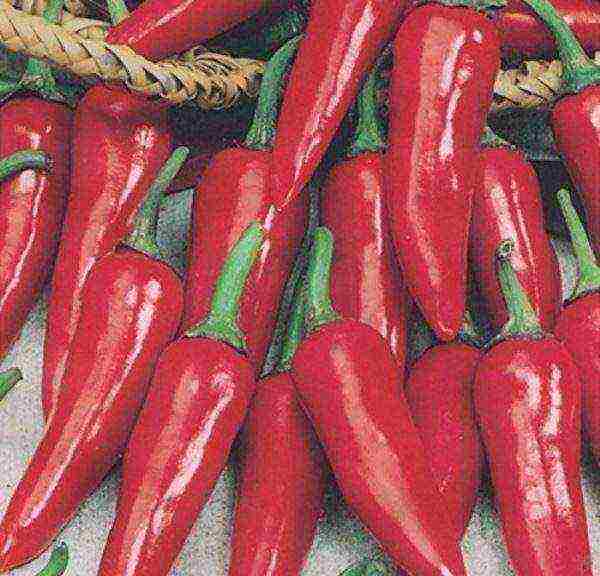 Hot pepper Tula grade
Hot pepper Tula grade
Early ripe. Grown in the open field and under a film. Medium bush, cone-shaped peppers, large, hot, red. The variety is high-vitamin, fruitful, plastic.
The best mid and late ripening varieties
Vizier
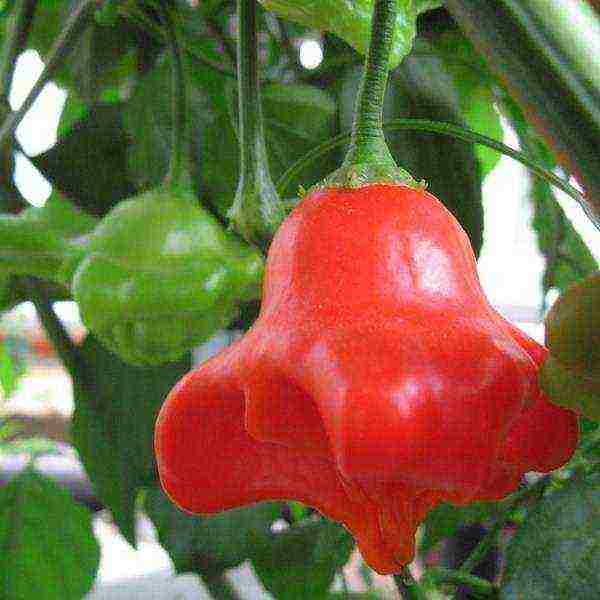 Hot pepper vizier
Hot pepper vizier
Late ripe. Grows indoors. The fruits are red, weighing up to 20 g. Medium spicy taste. The yield is good. It is used for the manufacture of paprika, salt, conservation.
Astrakhan
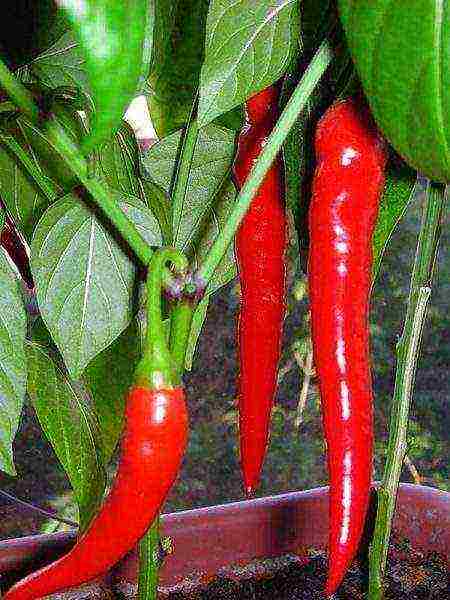 Hot pepper grade Astrakhansky
Hot pepper grade Astrakhansky
Mid-season ripening period. High yield, cultivated in open field with different climatic conditions. The fruits are small, red. The taste is acutely pungent. The pungency is determined by the capsaicin content. It is successfully used for culinary and medicinal purposes. Pepper tincture will relieve sciatica. Fresh pulp will heal abscesses. Hot pepper stimulates appetite, helps with pain, fever.
Ram horn
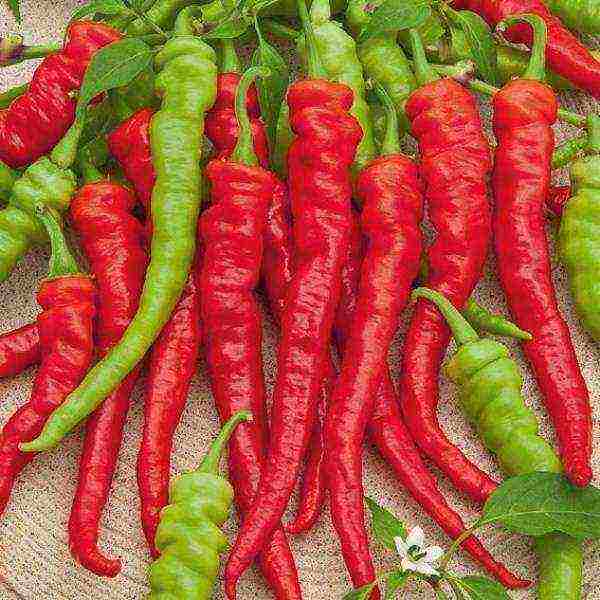 Hot Pepper Lamb Horn
Hot Pepper Lamb Horn
Mid-season. Unpretentious in cultivation, but does not tolerate stagnant water. With proper care, it gives a high yield. The pods are elongated, twisted like a ram's horn. The taste is not very pungent when well watered. If there is little watering, hot weather, the pepper will grow sharper. Suitable for trade, export.
Cayenne
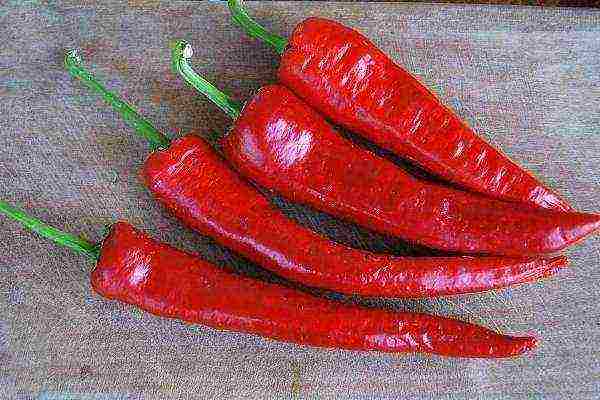 Hot pepper grade Cayenne
Hot pepper grade Cayenne
A relatively new species. It grows in greenhouses and in a room (seeds are pre-planted for seedlings). The yield is high.Fruits are thin, of medium length. The bushes are tall, reaching one and a half meters. It is imperative to tie up. The taste is relatively pungent. It is used for cooking, canning, processing into powder.
It is planted in open ground with seedlings.
Tabasco
 Hot pepper Tabasco
Hot pepper Tabasco
Shrub hot peppers. Grows on bushes in bunches upward. Fruits are orange-red, small. The pulp is juicy, fleshy, spicy. Productivity is high, disease resistant. The famous Tabasco sauce is made from this variety.
Popular varieties for giving
Among summer residents and owners of personal plots, Double Abundance, Superchili, Ogonyok are very famous.
Double abundance
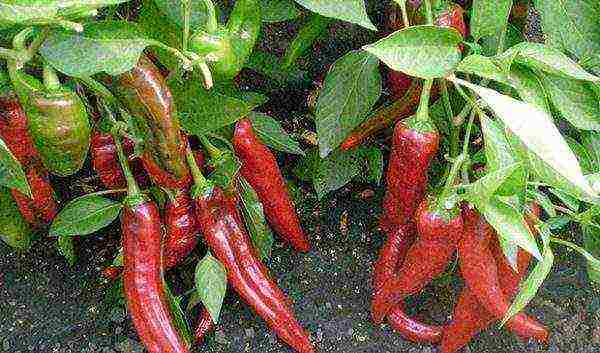 Hot Pepper Double Abundance
Hot Pepper Double Abundance
Early ripe variety. Grows in open and closed ground. Ranks first in terms of yield. Peppers are brightly colored, weigh up to 80 g... Dry peppers can be stored for several years without losing their appearance and taste. Equally good fresh and canned. Resistant to disease and heat.
Superchili
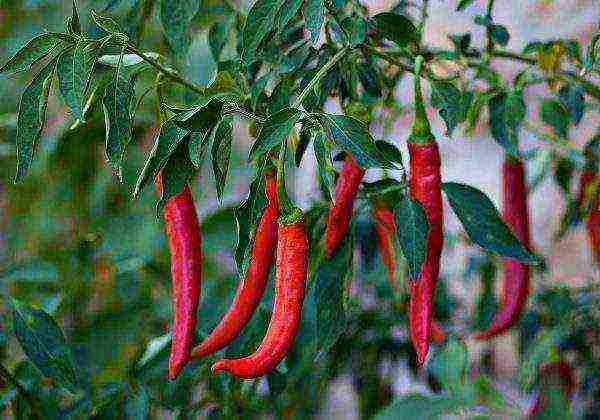 Super chili hot pepper
Super chili hot pepper
An early ripe hybrid variety. The yield is high, the taste is pungently burning. Super chili peppers are large, located under the foliage. Fully ripe fruits of almost cherry color... Eaten fresh, dried, salted.
This variety should not be grown next to other peppers in order to avoid over-pollination of the plants.
Twinkle
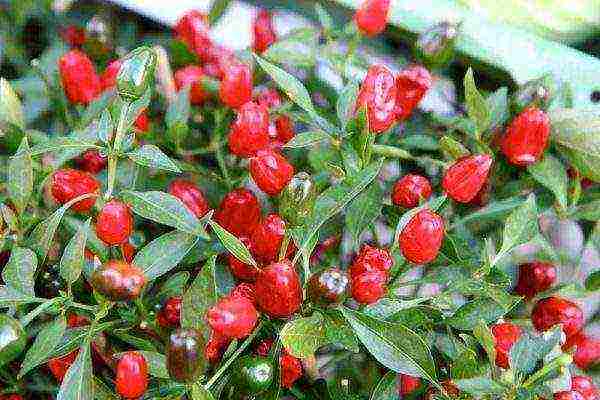 Hot pepper Spark
Hot pepper Spark
Spark is a fairly well-known, popular variety. Medium early ripening. Feels great outdoors and greenhouses. Fruits are not large enough, bright red. There are many of them on the bushes, they look like bright lanterns. Taste with special pungency and peppery aroma. This is due to the increased content of coloring pigments and dry substances. The fruits are dried naturally, stored in a glass container under a lid.
Resistant to bacteriosis and verticellosis wilt.
From such an abundance of piquant peppers, you can choose those that are suitable for taste, color, ripening time, types of storage, specifically for this site.
Hot pepper has many names - hot, chili, bitter. It is familiar to everyone, because it is used in the preparation of dishes in almost all cuisines of the world as a spicy seasoning. His homeland is the tropics of America and India. Even the Indians were engaged in the cultivation of this plant, which gives small red fruits. And now every lover of exquisite and unusual dishes considers it his duty to buy pepper in the store and use it in the cooking process.
Hot pepper
But what could be more interesting than trying to grow pepper on your own? This question is very relevant for summer residents. In order for this enterprise to be crowned with success, you should carefully consider the choice of the variety of hot pepper that you plan to cultivate in your personal plot.
Growing red pepper
Why do we need pepper
First, let's find out why we need hot peppers. The taste qualities of chili peppers are known to everyone, but few people know that such peppers are very useful.
The benefits of red hot pepper
Capsaicin, an alkaloid contained in the veins, skin, seeds of fruits, gives the pepper "thermonuclearness" and pungency. This substance is not found in any other vegetable. Hot peppers contain 20 times more capsaicin than sweet peppers.
The fruits of hot pepper contain a large amount of vitamins A, B, C and trace elements. By the way, hot pepper contains twice as much vitamin C than the most sour fruit - lemon. Chile is rich in carotene, which gives it its bright color, as well as essential oils and sugars.
The composition of the pepper per 100 gr. fruit
| Protein | 1.9 g |
| Carbohydrates | 7,3 |
| Fats | 0.44 g |
| Iron | 1.03 μg |
| Copper | 129 μg |
| Manganese | 187 mcg |
| Potassium | 322 μg |
| Phosphorus | 43 mcg |
| Beta carotene | 534 μg |
| Folic acid | 23 mg |
| Ascorbic acid | 144 mg |
| Riboflavin | 0.086 mg |
| Pyridoxine | 0.5 mg |
Caloric content - 40 kcal.
Note to beauties: capsaicin is a substance that improves hair growth.
Hot peppers improve hair growth
Red pepper can help relieve stress or relieve pain, as it helps our body produce endorphins, the resting hormone.
Red pepper as a pain reliever
Chile is a good helper in the prevention of cardiovascular diseases. It improves blood circulation, reduces the risk of blood clots.
The hot pepper stimulates the appetite, thereby improving digestion. But at the same time, it promotes weight loss by speeding up the metabolism.
Hot peppers are good for the heart and help you lose weight
Also in medicine, pepper helps to fight sleep disorders, prevents the development of cancerous tumors, arresting the effect of carcinogens, and is used in the treatment of lung diseases, allergies, and diseases of the musculoskeletal system.
Interestingly, in Sanskrit - the Indian language, chili pepper is called "Marishi-phadam", which means "fruit of the Sun".
Hot pepper came to Europe after the discovery of America by the navigator Christopher Columbus. Scientists of that time made an interesting observation: the Indians who inhabited the continent ate hot peppers straight from the bush, as we eat apples and other fruits. But at the same time, the Indians knew about the dangerous properties of pepper: for example, due to the fact that the natives put finely ground pepper on the coals of the fire, the Spanish invaders fled from the battlefield, since the smoke going in their direction was very pungent. Thus, the Indians were able to win one of the battles of that time.
Now chili is used in the production of gas cylinders for self-defense against intruders.
Pepper spray
Dangerous properties of hot peppers
| If you consume large amounts of pepper, there is a risk of developing gastrointestinal diseases: from gastritis to stomach cancer. | Do not use excessive amounts of chili in your cooking, or reduce your intake to a minimum if you are already experiencing stomach discomfort. |
| Carelessly working with pepper, you can get a severe chemical burn, comparable in pain to applying a hot iron to the skin. | Work with chili with gloves and be sure to cut your nails short to avoid capsaicin trapping on the skin under the nails. |
| Capsaicin accumulates on the mucous membranes gradually, so at first the dish may not seem spicy, and then you will have a feeling of "fire" in your mouth. You can get a burn of the mucous membrane. | If your mouth burns, drink milk or eat yogurt. It is useless to drink pepper with water, since capsaicin is an oily substance and does not mix well with water. |
| If chili gets in your eyes, you can get severe irritation. | Rinse eyes in tea leaves and apply anti-inflammatories to the eyes. Be sure to see a doctor. |
How to choose a variety
Choosing a variety of red pepper
About 40% of success in growing peppers depends on the correct choice of pepper variety. How not to make a gross mistake with such a variety of color packages that meet us on store shelves?
1. Think about the timing of ripening: there are varieties that will please you with fruits very quickly, and there are those who will "pull" from ripening to the last.
2. Consider the requirements for the cultivation and care of each variety: will you grow peppers in a greenhouse or on your window in an apartment.
Chili peppers on the window
3. Judge a variety by its yield level: some varieties produce a lot of fruits from one bush, so you do not need to breed an entire plantation of peppers.
4. Think about how sharp the fruits of the selected variety are. The pungency of a pepper can be estimated by looking at the "skoville" or SHU value.
The pungency of the peppers
By the way, the hottest pepper in the world is the Bhut Jolokia variety growing in India. The SHU value in his case is 1,000,000.
Think about how you will use the pepper: add it to your homemade preparations, dry and prepare the seasoning, or use it raw.
Carefully study the information on the package: as a rule, it is enough to draw conclusions about a particular variety.
Hot pepper varieties
Let's talk about the most popular varieties of hot peppers among summer residents. By the way, if anyone does not know, the varieties of hot peppers are divided into shrubby and savory.
The name "spicy" speaks for itself. These varieties of peppers are distinguished by their special "pungency" and brightness of taste. Usually these are fairly large peppers (up to 25 cm long). Most often they are used raw, as it is not very convenient to dry them due to their considerable size.
Shrubs will perfectly take root in your home as an ornamental plant: such bushes with tiny red fruits look very impressive. Moreover, such peppers can be eaten. The size of the fruits is up to 7 cm. Usually they are dried and seasonings are prepared from them.
Small-fruited varieties of pepper
It is very convenient to keep small-fruited varieties of peppers in the apartment: they feel great on windows and balconies, while they do not shed their foliage and can grow all year round.
The main varieties of hot peppers that are popular with summer residents
Cayenne pepper - the most popular hot pepper among gardeners around the world. The plant is up to 1 meter high, bears fruit with bright red, purple or yellow fruits weighing about 60 grams. The shape of the fruit is from a ball to an elongated proboscis. It is used both dry and fresh as a seasoning for soups, vegetable and meat dishes. The pungency is about 40,000 SHU. Loves warmth and sun.
Cayenne peppers - the base of salsa sauce, ketchup.
Cayenne pepper
Jalapeno - Mexican hot pepper with moderately hot red fruits (up to 8000 SHU). Harvesting is done when the fruit is still green, as the red jalapenos are considered to be of less quality than the green ones. The ripening period is about 80 days. Up to 35 fruits can be harvested from one bush up to 1 meter high. The shape of the fruit depends on the variety: from "plump" to fine pointed peppers. In Russia, it is grown only in greenhouses or hotbeds. Used in salads, frying or roasting.
Jalapeno pepper
Thai dragon - a variety that produces very small red hot peppers, while an adult bush sometimes reaches a height of 1.5 meters. Fruit size - up to 7 cm, ripening period is about 100 days. Popular in the preparation of Vietnamese and Thai cuisine. It is grown both outdoors and in greenhouses or in pots. The pungency is from 50 to 10 thousand SHU.
Thai dragon
Astrakhan hot pepper - a very spicy mid-season and high-yielding variety. The bushes are neat, compact. Fruits are small, conical, weighing about 10 grams. It is widely used in medicine.
Astrakhan hot pepper
Hungarian waxy yellow - mild pepper (about 10,000 SHU). Fruits are yellow (red or orange when ripe), large, up to 15 cm long, used for stuffing, pickled. Hungarian yellow is unpretentious and easily takes root in various climatic zones.
Hungarian Waxy Yellow Pepper
Satan's kiss - an Italian variety of hot pepper. Fruit pungency - up to 50 thousand SHU. The bush is tall, while the fruits are very small. It is widely used in the preparation of Italian dishes.
Satan's kiss
Chinese fire - a variety of peppers whose fruits are pickled or eaten raw. Its taste will be appreciated by fans of hot dishes. The color of the fruit is red or green, the shape is proboscis, curved towards the bottom. The length of the fruit reaches 25 cm in length. Unpretentious to growing conditions. The aging period is 100 days.
Chinese fire
Indian elephant - mid-season variety with a ripening period of about 130 days. The bush is tall and lush. Fruits are red or green in color, bright, proboscis-shaped. Suitable for outdoor and greenhouse cultivation. It is used in canning, for making salads, and the pepper is dried, and paprika is prepared from it, since the pepper is very fragrant.
Indian elephant
How to grow peppers in a greenhouse or at home
Having decided on the choice of the variety and purchasing the desired seeds, you can start planting peppers.
- To help the seeds germinate, soak them in water for a while.
- Prepare the soil and boxes: mix 1 part of the purchased soil, sand and black soil, adding a little vermiculite. The soil pH should be around 6.5. Pour the resulting soil mixture into boxes or pots, moisten well.
- Use a match or toothpick to make small indentations in the soil.
- We begin to plant the prepared seeds in a container. The room temperature should be around 26 degrees. The seeds are placed in the prepared grooves and carefully sprinkled with earth.
- We close the container with foil and put it in a warm and bright room. We are waiting for seedlings.
- When the first shoots have appeared, we reduce the air temperature to 22 degrees during the day and 20 at night.
Growing hot pepper
- If the peppers are sitting in your boxes, then when the seedlings get stronger, the seedlings are dived and planted in separate containers.
- Water the seedlings regularly, preventing the soil from drying out or excessive moisture.
- Grown plants are planted in a greenhouse or greenhouse, or remain to live on your windowsills.
Seedling red pepper
Harvesting hot peppers
Stocking up on hot pepper
There are several ways to prepare pepper for the winter:
- ambassador;
- pickling;
- freezing;
- grinding and drying;
- pepper is used in the preparation of various homemade products: adjika, pickled tomatoes and so on.
It is very good if the pepper is well dried and chopped thoroughly - then you get a delicious and aromatic seasoning for almost any dish.
Dried peppers
Video - Hot peppers, growing at home
Video - Growing hot peppers
